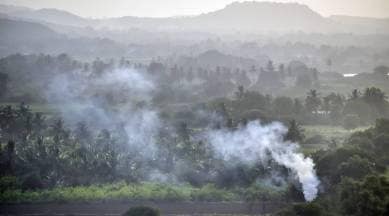Stay updated with the latest - Click here to follow us on Instagram
Bagalkot: An ode to Karnataka’s scenic beauty in photos
Bagalkot in northern Karnataka offers a soothing respite after the fast-paced rush of neon-soaked cities. Jithendra M captures some of its pristine beauty.

Written by Jithendra M
The scenic beauty of Bagalkot is a treat to watch. In the hinterland, away from the fast paced life of the city, the lush green surroundings encompassing agricultural lands and the onset of monsoon sends a picture straight out of an art book. The red soil covering the large tracts of agricultural fields in the region sustains the growth of local crops.
monthly limit of free stories.
with an Express account.
The picturesque environment, where farmers are seen ploughing fields, huts are constructed for dwellers and cattle are grazing, defines Bagalkot.
The average rainfall in Bagalkot is 320 mm annually. A semi arid region in northern Karnataka, agriculture is the biggest source of employment in Bagalkot with over 65 per cent of the population in the district dependent on it. With the south-west monsoon hitting Karnataka early this month, farmers have started ploughing the agricultural lands using the traditional bullock cart methods.
The black soil in Bagalkot supports the growth of cotton and is the biggest contributor to the district’s economy. Red soil is also there- it supports for the growth of wheat, pulses, millets, oilseeds and fruits. The major crops grown here are sorghum, maize, wheat, groundnut, sunflower, green gram, red gram, Bengal gram, sugarcane and cotton. Horticultural crops like sapota, pomegranate, banana, grapes, lime and papaya are also grown extensively in the district.
The water supply for irrigation is done from nearby reservoirs such as the Kendur reservoir. Locals say that due to heavy rainfall in the past few days the reservoir is brimming with water. Since the region has scant rainfall the dependence on water from reservoirs is large. Though the population being largely dependent on agriculture, the district reports the highest number of farmer suicides in Karnataka.